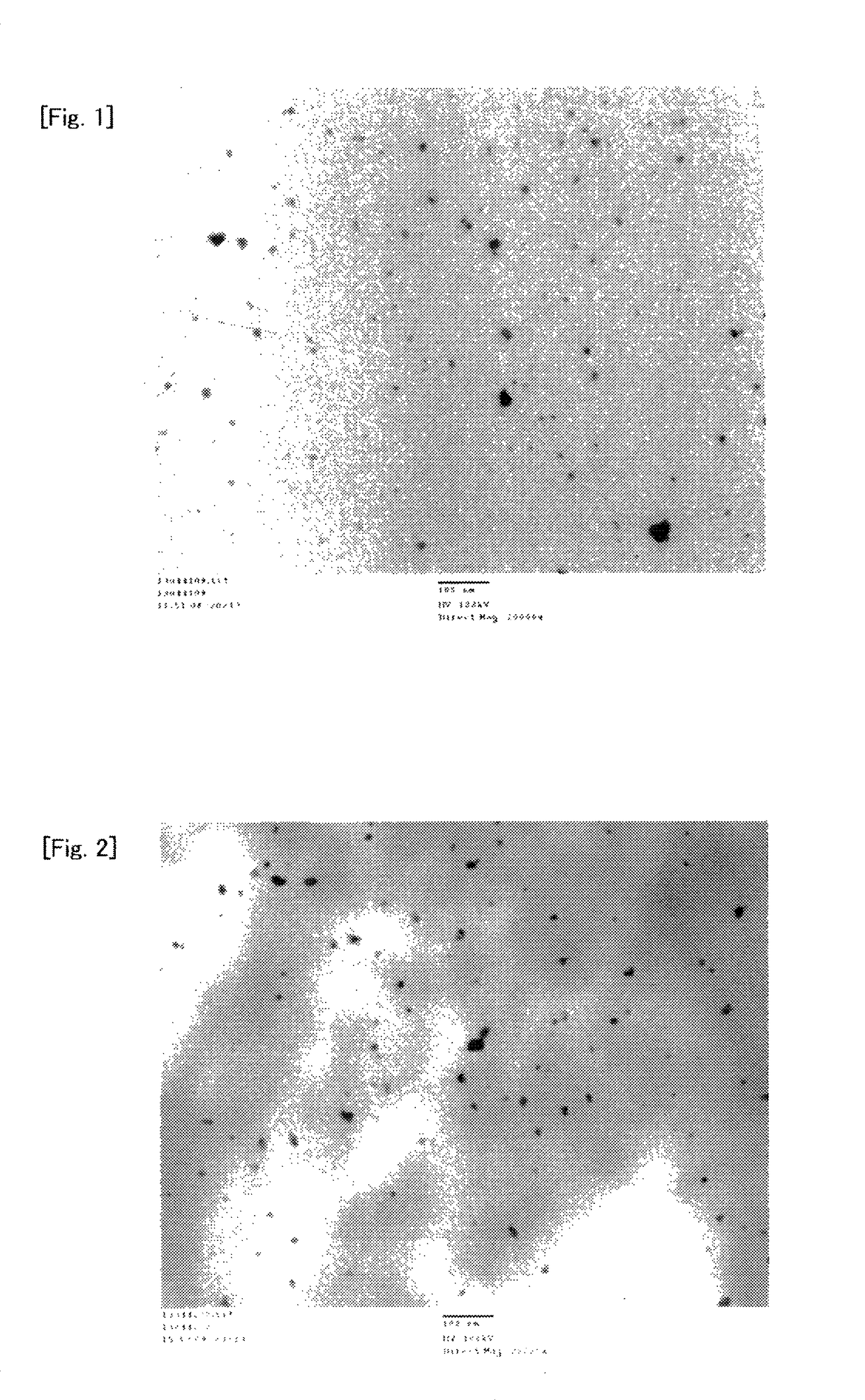Polyarylene sulfide resin composition and method for producing same
a technology resin composition, which is applied in the field of polyarylene sulfide resin composition, can solve the problems of metal powder easily falling, increasing in size, and expensive pressurized vessels, and achieves the effect of catalytic activity in conversion
- Summary
- Abstract
- Description
- Claims
- Application Information
AI Technical Summary
Benefits of technology
Problems solved by technology
Method used
Image
Examples
reference example 1
Preparation of Cyclic Polyarylene Sulfide
[0249]In a stainless autoclave provided with an agitator were added 28.06 g (0.240 mol) of a 48 wt % aqueous solution of sodium hydrosulfide, 21.88 g (0.252 mol) of a 48 wt % aqueous solution prepared using 96% sodium hydroxide, 615.0 g (6.20 mol) of N-methyl-2-pyrrolidone (NMP) and 36.16 g (0.246 mol) of p-dichlorobenzene (p-DCB). The inside of a reaction vessel was sufficiently purged with nitrogen, and then hermetically sealed under a nitrogen gas.
[0250]The mixture was heated from room temperature to 200° C. for about 1 hour while being agitated at 400 rpm. The mixture was then heated from 200° C. to 250° C. for about 30 minutes. The mixture was held at 250° C. for 2 hours, and then rapidly cooled to a temperature close to room temperature, and contents were then collected.
[0251]The obtained contents (500 g) were diluted with about 1500 g of ion exchanged water, and then filtered with a glass filter with an average aperture of 10 to 16 μm....
reference example 2
Synthesis of Polyphenylene Sulfide Resin
[0254]In an autoclave were added 118 g (1 mol) of a 47 wt % aqueous sodium hydrosulfide solution, 42.9 g (1.03 mol) of 96% sodium hydroxide, 162 g (1.64 mol) of N-methyl-2-pyrrolidone (NMP), 28.8 g (0.35 mol) of sodium acetate and 150 g of ion exchanged water, and the mixture was gradually heated to 235° C. for 3 hours while nitrogen was introduced at normal pressure, so that 213 g of water and 4.0 g (40.4 mmol) of NMP were distilled away, followed by cooling the reaction vessel to 160° C. The scattered amount of hydrogen sulfide was 25 mmol.
[0255]Next, 148 g (1.01 mol) of p-dichlorobenzene (p-DCB) and 131 g (1.33 mol) of NMP were further added, and the reaction vessel was hermetically sealed under a nitrogen gas. The mixture was heated at a rate of 0.6° C. / minute from 200° C. to 270° C. while being agitated at 400 rpm, and the reaction was continued at 270° C. for 140 minutes. Thereafter, 33.3 g (1.85 mol) of water was injected into the syste...
reference example 3
Preparation of Nickel Formate Anhydride
[0258]In a glass ampoule in the air was added 300 mg of nickel formate dihydrate (Ni(HCOO)2.2H2O (manufactured by Wako Pure Chemical Industries, Ltd.), and the inside of the ampoule was purged with nitrogen, and then decompressed to about 0.4 kPa using a vacuum pump. About 10 seconds after the decompression to about 0.4 kPa, the ampoule was placed in an electric furnace with the temperature adjusted to 150° C., the inside of the ampoule was heated for 30 minutes while being kept at a pressure of about 0.4 kPa and degassed by a vacuum pump, and the ampoule was then taken out, and cooled to room temperature to obtain a light green solid. In absorption spectrum in infrared spectroscopic analysis of the solid, a peak at 3100 to 3400 cm−1 originating from O—H of hydrated water of nickel formate dihydrate disappeared, and thus the solid was confirmed to be nickel formate anhydride.
PUM
| Property | Measurement | Unit |
|---|---|---|
| particle size | aaaaa | aaaaa |
| particle size | aaaaa | aaaaa |
| particle size | aaaaa | aaaaa |
Abstract
Description
Claims
Application Information
 Login to View More
Login to View More - R&D
- Intellectual Property
- Life Sciences
- Materials
- Tech Scout
- Unparalleled Data Quality
- Higher Quality Content
- 60% Fewer Hallucinations
Browse by: Latest US Patents, China's latest patents, Technical Efficacy Thesaurus, Application Domain, Technology Topic, Popular Technical Reports.
© 2025 PatSnap. All rights reserved.Legal|Privacy policy|Modern Slavery Act Transparency Statement|Sitemap|About US| Contact US: help@patsnap.com



